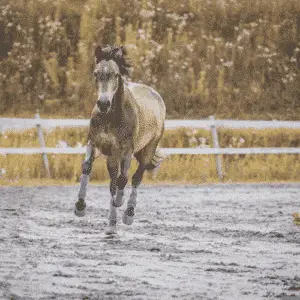
Active Stables for Horses
Constant Free Movement in Herds Can Help Against Obesity We always talk about how feed

“Straighten your horse!”—every rider has probably heard this phrase from their instructor at least once. But what does straightening a horse actually mean, and what exercises can help?
In this article, you’ll learn how to quickly and easily train your horse evenly on both reins, even when riding on your own. Use the Happie Horse App to help correct your horse’s natural crookedness.
The most important reason to straightening a horse is for its health. Ensuring even weight distribution can help prevent early signs of wear and tear. Although straightening is the fifth element of the training scale, it’s considered from the very beginning of a young horse’s training. There are many exercises designed to reduce a horse’s natural crookedness, and it’s crucial to train both sides equally right from the start.
When riding, an additional challenge arises: the rider must be aware of the horse’s natural crookedness to avoid sitting unevenly. A riding instructor, a mirror, or another rider can be helpful in keeping an eye on this.
The concept of riding from your core to bring both horse and rider into balance is beneficial here. Even when riding straight, the principle is to frame the horse with leg and weight aids, rather than forcing straightness through the reins alone.
But why do we need to focus so much on straightening a horses? After all, the horse seems to be moving straight! Unfortunately, that’s not quite true. Horses naturally have a “hollow” side and a “stiff” side.
The “hollow side,” or the horse’s natural crookedness, shows itself when the horse tries to avoid bearing weight by pushing its inner hind leg to the side. You can easily check this yourself by looking at the hoof prints in the sand after a workout. The hind hoof should not step past the front hoof’s track. While natural crookedness doesn’t significantly affect horses moving freely, it can lead to persistent strain during dressage exercises if not corrected.
The goal of straightening is to ensure that the horse can perform all exercises and movements equally, smoothly, and correctly on both reins. Improving rib cage flexibility and straightening the horse are tasks that will continue to be important throughout the horse’s life, as natural crookedness always needs to be managed.

The natural crookedness of a horse is why it’s easier to bend on one rein than the other. The horse in Fig. 1, for example, would have its “strong side” on the left, meaning it prefers turning left and picking up the left lead in canter. But why is this? It’s actually quite simple to explain.
On the left side, the horse’s muscles are slightly shorter, leading to an incorrect bend. The horse puts more weight on the right front leg (indicated by the red hoof symbol) and avoids contact with the left rein by bending its neck to the side. When riding turns, you’ll notice that the horse tends to drift outward through the right shoulder on the open side of the arena, enlarging the circle.
However, when you switch to the right rein, the horse will feel stiff. Riders often start by loosening the horse on its hollow side and then focus more on the stiff side, but this approach is flawed. It can be counterproductive because it overworks the already stronger side, making it even more dominant. The goal should be to strengthen the weaker side, not weaken the stronger one. The basic principle here is to bring and maintain the forehand in line with the pushing hindquarters.
Tip: Imagine that when riding straight, you want to keep the withers aligned between the poll and the tail to achieve straightness. Gustav Steinbrecht summed this up perfectly back in 1881 with his famous phrase, “Ride your horse forward and make it straight.”
Gymnastic exercises such as serpentines across the arena, frequent changes of direction, tempo changes, and riding figure eights with crossing over on the stiffer side are all beneficial. If your horse is more advanced, exercises like lateral movements can continuously improve the rib cage flexibility. The shoulder-fore exercise, for example, helps control the forehand, making it easier to align it with the hindquarters and encouraging the inner hind leg to step more under the center of gravity. This is key to straightening your horse.
If you enjoy trail riding, you can practice many of these exercises outdoors as well. Just remember to include frequent breaks and approach the work gradually to avoid both physical and mental strain on your horse.
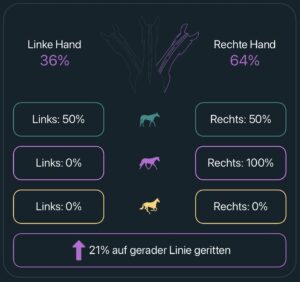
The Happie Horse App offers a practical analysis tool for your rides, including a left-right distribution feature. This allows you to check how balanced your training truly is and how well you’re progressing with straightening your horse. Often, our instincts can be misleading, but the app analyzes your ride and shows you how much time you spent on each rein. Additionally, it provides data on gaits, transitions, speeds, and the distance covered.
By the way, a horse usually carries its main mane on its hollow side—this “rule” applies to about 75% of horses. So, the hollow side is often the side where the mane falls. Does this rule apply to your horse?
The Happie Horse App can assist you in straightening your horse. You can track whether you’re working your horse evenly on both reins, which is crucial for maintaining your four-legged friend’s health. The app also provides exercises that can help with straightening. Remember, straightening is a task that will stay with you throughout your horse’s life, as natural crookedness is always present.
Download the app for free and enjoy a 7-day free trial of the premium features!

Constant Free Movement in Herds Can Help Against Obesity We always talk about how feed
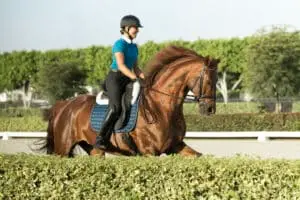
“Straighten your horse!”—every rider has probably heard this phrase from their instructor at least once.
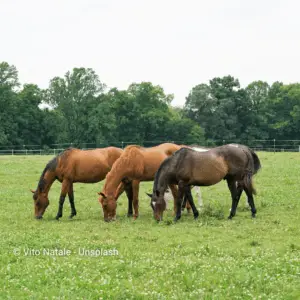
How To Aviod Boredom Enrichments for horses that can’t be ridden can be an important
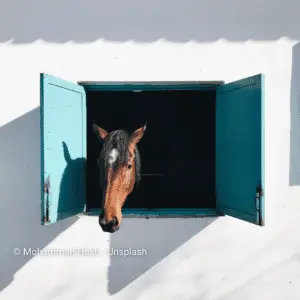
How to Avoid Boredom in the Stable Stable enrichments are important since they provide mental

Rewarding Your Horse With a Clicker Clicker training is a modern training method that has
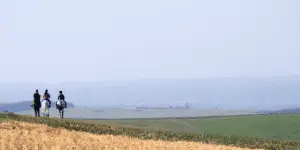
It’s stubble field season! As a rider, there’s almost nothing better than galloping across the